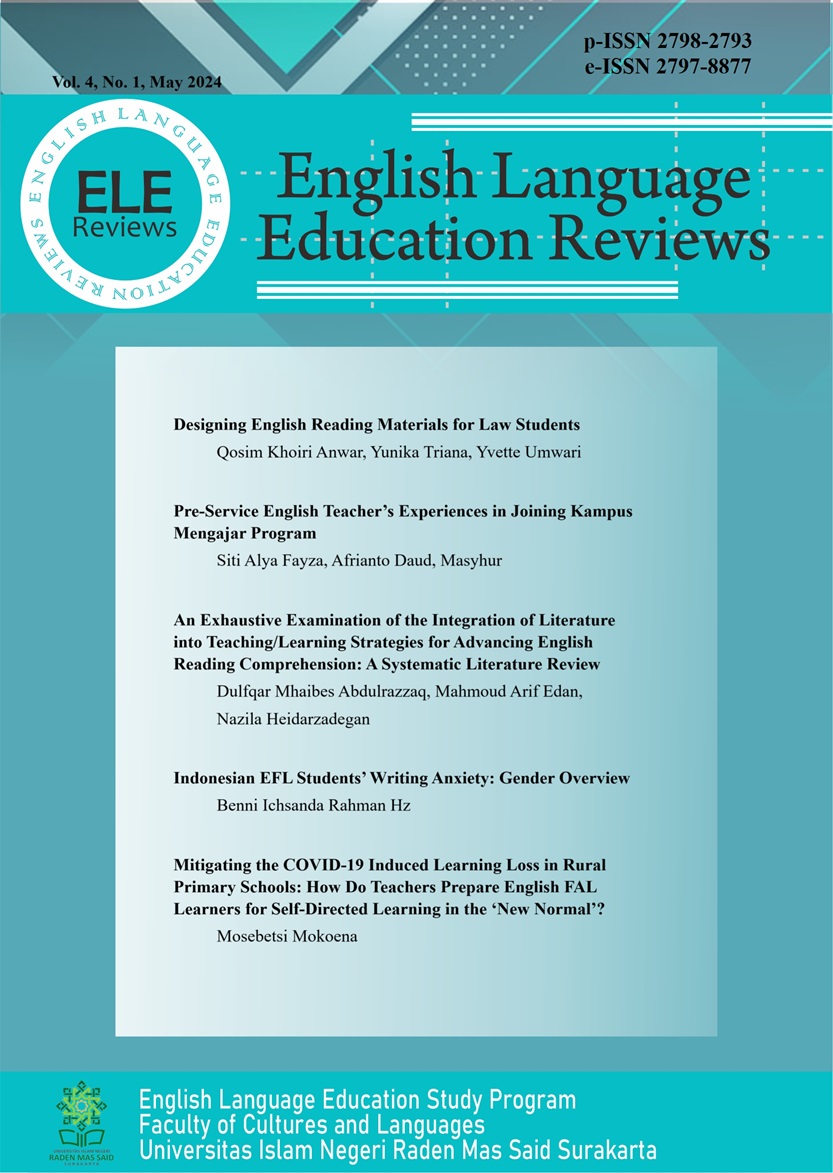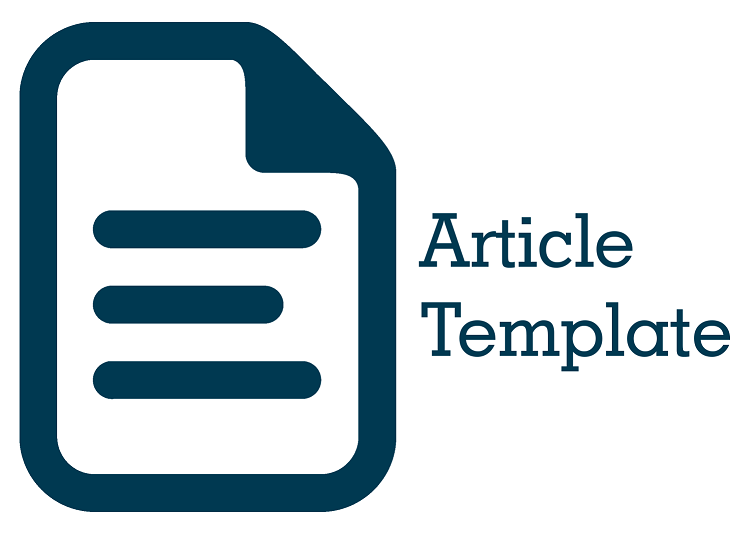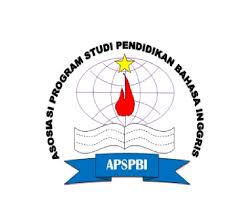An Exhaustive Examination of the Integration of Literature into Teaching/Learning Strategies for Advancing English Reading Comprehension: A Systematic Literature Review
DOI:
https://doi.org/10.22515/elereviews.v4i1.7637Keywords:
literature review, reading comprehension, learning and teaching, short-story, novelAbstract
This study aims to provide an extensive literature review of previous studies conducted to demonstrate and investigate the effectiveness of using literature in teaching and learning reading comprehension at the middle education level. Consequently, this literature review was conducted using a systematic approach, involving searches across multiple academic databases on the addressed topic, which resulted in highlighting twenty articles conducted between 2010 and 2021. The systematic review method included identifying relevant studies, evaluating their quality, and synthesizing their findings. Furthermore, the researchers divided the main findings into two groups: the first one focused on using short stories, and the second group included all other literary genres. Both groups showed the positive effect of using short stories, comic stories, or novels as an efficacious method in developing, teaching, and learning reading comprehension skills, especially for adolescents and children. Therefore, this study suggests using different literary genres such as children’s short stories, fiction, and plays in middle education classrooms and employing new reading techniques and strategies to further motivate students. In addition, it recommends using a larger population and random assignment when selecting samples for future studies.
Downloads
References
Adams, N. E. (2015). Bloom’s taxonomy of cognitive learning objectives. Journal of the Medical Library Association, 103(3), 152-153. https://doi.org/10.3163%2F1536-5050.103.3.010
Alturki, N. (2017). The effectiveness of using group story-mapping strategy to improve reading comprehension of students with learning disabilities. Educational Research and Reviews, 12(18), 915-926.
Bekmuratova, R., Tilekova, N., Usarova, G., Alibekova, U., Tolonova, G., Ismailova, B., Ukueva, B., & Abdullaeva, Z. (2020). Development of students reading competence through the novel “The Day Lasts More than a Hundred Years.” Open Journal of Modern Linguistics, 10, 606-619. https://doi.org/10.4236/ojml.2020.105037
Brown, H. D., & Abeywickrama, P. (2019). Language assessment: Principles and classroom practices (3rd ed.). Pearson.
Carder, M. (2007). Bilingualism in international schools: A model for enriching language education. Multilingual Matters.
Collie, J., & Slater, S. (1987). Literature in the language classroom. Cambridge University Press.
Daniels, H. (2002). Literature circles: Voice and choice in book clubs and reading groups. Routledge.
Dogan, B., Cermik, H., Yildirim, K., & Ates, S. (2021). The effects of literature circles experiences on primary school students’ attitudes towards reading. International Journal of Eurasian Education and Culture, 6(12), 88-148. https://doi.org/10.35826/ijoecc.308
Eltayb, K. H. A. (2020). The cruciality of using literature to enhance reading comprehension skills. International Journal Online of Humanities (IJOHMN), 6(4), 44-59. https://doi.org/10.24113/ijohmn.v6i4.193
Frimasary, A. E., & Syahrial, S. (2018). Using short story to improve student’s reading comprehension (a study at the second year student of SMPN 2 Kota Bengkulu). JOALL: Journal of Applied Linguistics and Literature, 2(1), 44-50. https://doi.org/10.33369/joall.v2i1.5868
Grellet, F. (2008). Developing reading skills: A pratical guide to reading comprehension exercises. Cambridge University Press.
Handayani, M. P. (2013). Using children short stories to enhance students’ reading comprehension. Journal of English and Education, 1(1), 133-141.
Harmer, J. (2007). The practice of English Language Teaching (4th ed.). Pearson Longman.
Hasbaini, H., & Manan, A. (2017). Teaching reading comprehension by using short stories. English Education Journal, 8(3), 404-423.
Irawati, D. (2016). Effectiveness of literature circles on students’ reading comprehension. Indonesian Journal of Language Teaching and Linguistics, 1(3), 179-192. https://doi.org/10.30957/ijoltl.v1i3.183
Julianti, N. F. A., Fakhruddin, A., & Ilyas, R. (2018). Using literature circles strategy in teaching reading comprehension. Journal of English Language Learning, 2(1), 7-15.
Karatay, H. (2017). The effect of literature circles on text analysis and reading desire. International Journal of Higher Education, 6(5), 65-75. https://doi.org/10.5430/ijhe.v6n5
Lazar, G. (2010). Literature in language teaching. Cambridge University Press. https://doi.org/10.1017/CBO9780511733048
McElvain, C. M. (2010). Transactional literature circles and the reading comprehension of English learners in the mainstream classroom. Journal of Research in Reading, 33(2), 178-205. https://doi.org/10.1111/j.1467-9817.2009.01403.x
Mohandas, E. S., Azlan, N. M. N. I., Othman, S., & Azhar, M. A. (2019). Employing personal reading logs through short stories to enhance students’ L2 reading comprehension achievement. International Journal of Modern Languages and Applied Linguistics, 3(2), 1-6. https://doi.org/10.24191/ijmal.v3i2.7643
Novasyari, R. (2019). The use of literature-based instruction to improve reading comprehension and writing achievements of the eighth grade students. The Journal of English Literacy Education, 6(2), 61-73. https://doi.org/10.36706/jele.v6i2.9278
Nurhadi, K. (2017). Developing students’ reading comprehension by using literature circle. Wiralodra English Journal, 1(1), 27-36. https://doi.org/10.31943/wej.v1i1.15
Okewole, J. O., Odejobi, C. O., & Ajayi, H. O. (2018). Effects of literature circles, dialogic reading and vocabulary self-selection strategies on the reading comprehension skill of lower primary school in Osun State, Nigeria. Journal of Education and Practice, 9(5), 29-36.
Pardede, P. (2011). Using short stories to teach language skills. Journal of English Teaching, 1(1), 14-27. https://doi.org/10.33541/jet.v1i1.49
Pathan, M. M. (2012). Advantages of using short-stories in ELT classroom and the Libyan EFL learners’ perceptions towards them for developing reading comprehension skill. Arab World English Journal, 4(1), 28-41.
Piscayanti, K. S. (2010). The effect of literature-based instruction on student’s English achievement with differing achievement motivation an experimental study on the eighth grade students of SMPN 1 Singaraja in academic year 2009-2010. Jurnal Ilmiah Pendidikan dan Pembelajaran Ganesha, 7(1), 1-15.
Rosenblatt, L. M. (1994). The reader, the text, the poem: The transactional theory of the literary work. Southern Illinois University Press.
Schraw, G., & Moshman, D. (1995). Metacognitive theories. Educational Psychology Review, 7(4), 351-371.
Sultan, A., Nafi, J., Qabaja, Z., & Al-abed, S. (2018). The effect of using short stories on the development of 5th graders’ reading comprehension skills in Hebron District. International Journal of English Language Teaching, 5(4), 1-27.
Syafii, M. L. (2018). Using online short stories to improve the reading comprehension ability. Register Journal, 11(2), 168-191. https://doi.org/10.18326/rgt.v11i2.168-191
Syarief, I. F., Apsari, Y., & Dewi, A. N. K. (2020). The use of book story in teaching reading comprehension. Professional Journal of English Education, 3(2), 276-282. https://doi.org/10.22460/project.v3i2.p276-282
Thomas, D. M., & Kim, J. K. (2019). Impact of literature circles in the developmental college classroom. Journal of College Reading and Learning, 49(2), 89-114. https://doi.org/10.1080/10790195.2019.1582371
Tosun, D. K., & Dogan, B. (2020). The effects of literature circles on reading fluency, reading comprehension and reader responses: A mixed method study. Education and Science, 45(203), 153-176. https://doi.org/10.15390/EB.2020.8716
Tyson, L. (2006). Critical theory today: A user-friendly guide (2nd ed.). Routledge.
Varga, A. (2016). Metacognitive perspectives on the development of reading comprehension: A classroom study of literary text-talks. Literacy, 51(1), 19-25. https://doi.org/10.1111/lit.12095
Downloads
Published
How to Cite
Issue
Section
Citation Check
License
Copyright (c) 2024 Dulfqar Mhaibes Abdulrazzaq, Mahmoud Arif Edan, Nazila Heidarzadegan

This work is licensed under a Creative Commons Attribution-NonCommercial 4.0 International License.
Authors retain copyright and grant the journal right of first publication with the work simultaneously licensed under a Creative Commons Attribution License that allows others to share the work with an acknowledgement of the work's authorship and initial publication in this journal.
This ejournal system and its contents are licensed under
a Creative Commons Attribution-NonCommercial 4.0 International License








